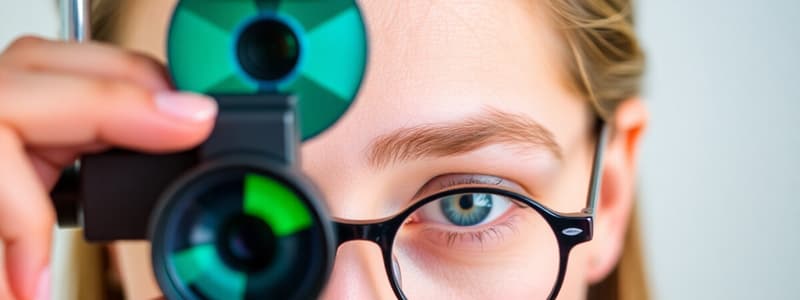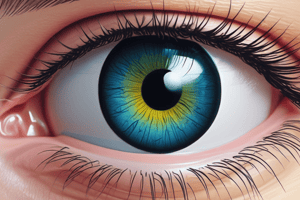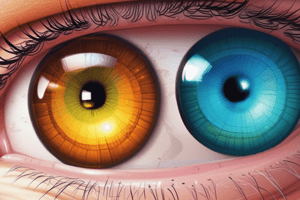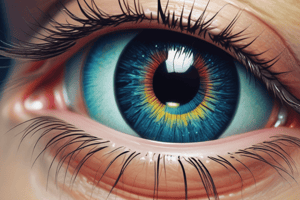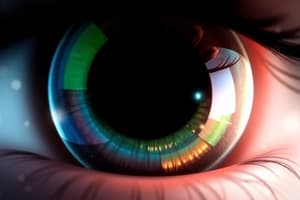Podcast
Questions and Answers
What aspect does the dynamic fit primarily assess during the examination of contact lenses?
What aspect does the dynamic fit primarily assess during the examination of contact lenses?
- The visual acuity of the patient
- The material properties of the lens
- Lid interaction and movement on blink (correct)
- Corneal curvature measurements
Which measure is essential for ensuring optimal optics in contact lens fitting?
Which measure is essential for ensuring optimal optics in contact lens fitting?
- The lens diameter size
- The position of the lens center in relation to the cornea (correct)
- The lens color and design
- The overall thickness of the lens
What is the implication of a lens crossing the limbus during dynamic fitting?
What is the implication of a lens crossing the limbus during dynamic fitting?
- It can lead to discomfort and mechanical problems (correct)
- It does not affect contact lens comfort
- It indicates high tear film stability
- It suggests the lens fits correctly
During the dynamic fit examination, what measurements are crucial for assessing movement on blink?
During the dynamic fit examination, what measurements are crucial for assessing movement on blink?
What indicates a low riding lens during lid interaction assessment?
What indicates a low riding lens during lid interaction assessment?
What is a potential indicator of a flat fitting contact lens during dynamic fit assessment?
What is a potential indicator of a flat fitting contact lens during dynamic fit assessment?
What is the range of expected movement in millimeters for a contact lens in a typical dynamic fit?
What is the range of expected movement in millimeters for a contact lens in a typical dynamic fit?
Which gaze excursion indicates a problematic edge position if the lens touches the inferior-nasal limbus?
Which gaze excursion indicates a problematic edge position if the lens touches the inferior-nasal limbus?
What is the ideal fluorescein pattern for a properly fitting lens under the central area?
What is the ideal fluorescein pattern for a properly fitting lens under the central area?
What component should be used in conjunction with fluorescein for assessing static fit?
What component should be used in conjunction with fluorescein for assessing static fit?
When assessing the mid-periphery of the lens, which of the following would indicate a poor fit?
When assessing the mid-periphery of the lens, which of the following would indicate a poor fit?
What type of astigmatism is more common in younger individuals?
What type of astigmatism is more common in younger individuals?
What common error can occur if there is insufficient fluorescein present during the assessment?
What common error can occur if there is insufficient fluorescein present during the assessment?
If a lens exhibits central touch, what does this typically indicate about the fit?
If a lens exhibits central touch, what does this typically indicate about the fit?
Which characteristic is NOT optimal for RGP lens patient selection?
Which characteristic is NOT optimal for RGP lens patient selection?
What is the significance of the steepest curvature in oblique astigmatism?
What is the significance of the steepest curvature in oblique astigmatism?
What characteristic should be observed in an ideal edge clearance of a lens?
What characteristic should be observed in an ideal edge clearance of a lens?
Which process is part of the RGP fitting technique?
Which process is part of the RGP fitting technique?
What is the recommended course of action if a lens is found to be poorly centered during an assessment?
What is the recommended course of action if a lens is found to be poorly centered during an assessment?
What characteristic of RGP lenses allows them to work effectively for astigmatism?
What characteristic of RGP lenses allows them to work effectively for astigmatism?
What fitting characteristic would be expected for a lens described as a steep fit based on fluorescein patterns?
What fitting characteristic would be expected for a lens described as a steep fit based on fluorescein patterns?
What measurement indicates when a back surface toric lens is required for fitting?
What measurement indicates when a back surface toric lens is required for fitting?
At what points of the eye's curvature do the steeper and flatter curvatures of astigmatism occur?
At what points of the eye's curvature do the steeper and flatter curvatures of astigmatism occur?
How does astigmatism typically evolve over a person's lifetime?
How does astigmatism typically evolve over a person's lifetime?
Flashcards
With-the-rule (WTR) astigmatism
With-the-rule (WTR) astigmatism
A type of astigmatism where the cornea is more curved in the vertical meridian.
Against-the-rule (ATR) astigmatism
Against-the-rule (ATR) astigmatism
A type of astigmatism where the cornea is more curved in the horizontal meridian.
Oblique astigmatism
Oblique astigmatism
A type of astigmatism where the steepest corneal curvature lies between 120 and 150 degrees or 30 and 60 degrees.
What is an RGP?
What is an RGP?
Signup and view all the flashcards
RGP Patient Selection
RGP Patient Selection
Signup and view all the flashcards
RGP Fitting
RGP Fitting
Signup and view all the flashcards
Dynamic fit
Dynamic fit
Signup and view all the flashcards
Static fit
Static fit
Signup and view all the flashcards
Fluorescein
Fluorescein
Signup and view all the flashcards
Cobalt blue light
Cobalt blue light
Signup and view all the flashcards
Central pooling fluorescein pattern
Central pooling fluorescein pattern
Signup and view all the flashcards
Central touch fluorescein pattern
Central touch fluorescein pattern
Signup and view all the flashcards
Apical clearance fluorescein pattern
Apical clearance fluorescein pattern
Signup and view all the flashcards
Wratten filter
Wratten filter
Signup and view all the flashcards
Static Fit with Fluorescein
Static Fit with Fluorescein
Signup and view all the flashcards
Lens Back Surface Relation to Cornea
Lens Back Surface Relation to Cornea
Signup and view all the flashcards
Cobalt Blue/Burton Lamp
Cobalt Blue/Burton Lamp
Signup and view all the flashcards
Centration
Centration
Signup and view all the flashcards
Lid Interaction
Lid Interaction
Signup and view all the flashcards
Edge Position
Edge Position
Signup and view all the flashcards
Study Notes
Lecture Recording Information
- Lectures are recorded and available via Panopto on module DLE pages
- Comments and questions may appear on recordings
- Students can ask lecturer to pause recording if they do not want their comments included
RGP Selection and Assessment of Fit
- Topic of the lecture is RGP Selection and assessment of fit
- Presenter is Dr Asma Zahidi
- Lecture code is OPT506, Specialist Optometry Skills
Types of Astigmatism
- With the rule (WTR): Cornea more curved in the vertical meridian
- Against the rule (ATR): Cornea more curved in the horizontal meridian
- Astigmatism decreases over early years and changes with age
- Astigmatism tends to be with the rule when young and against the rule when older
- Oblique: Steepest curve lies between 120-150 degrees or 30-60 degrees
RGP Series
- Patient selection
- Trial lens selection
- Application
- Fitting
- Removal
- Tear lens
- Over refraction
Introduction to RGP
- Made of material that allows oxygen to pass through to cornea
- Rigid, small and durable
- Provide good vision correction
- Often works well with astigmatism
- Less expensive in the long term
Patient Selection Criteria
- Optimal anterior eye characteristics
- High motivation
- Moderate to high prescription
- Corneal toricity: 0.25D to 2.00D
- Residual cylinder <0.75D
- Myopia control, normal lid tension
Trial Lens Selection - BOZR
- Importance of corneal curvature/astigmatism
- Keratometry readings used
- HVID and VPA readings also important
- Related to maximum pupil diameter in low light situations
- Spectacle Rx important for selection
Trial Lens Selection - TD & BOZD
- TD generally 1.5-3mm smaller than HVID
- Increasing TD stabilises fitting & increases lid attachment
- Manufacturer often sets TD for a lens
- Need to consider VPA
- BOZD generally 1.5mm larger than pupil size
- Manufacturer typically sets this value
RGP Fit - Alignment Fit
- Back surface of the lens mimics front surface of cornea
- Pressure evenly distributed on cornea
- Limits effect of the lens on cornea
- Comfortable fit
- Sufficient edge clearance for tear exchange and lens removal
RGP Fit - Example
- 7.80@180/7.75@90 cornea fitted with 7.80 lens
Selecting Lenses for Trial (BOZR)
- Spherical cornea- BOZR aligns across both meridians
- Toric cornea - BOZR aligns over the flattest meridian- lens forms along the steeper meridian
Trial Lens Selection - BVP
- Consider BVD (lens sits closer to the eye than specs)
- Compare corneal astigmatism with spectacle astigmatism
- Correct for BVD if spectacle Rx ≥ ±4.000D
Fluorescein Patterns
- Best indicator of fit is fluorescein pattern
- Can easily be confused by too much/little fluorescein
- May need to re-centre lens for accurate assessment
- Ask patient look down/straight to re-centre lens
Static Fit
- Fluorescein & cobalt blue/burton lamp visualises the tear lens
- Allows interpretation of how the lens surface relates to cornea
- Insert fluorescein on superior bulbar conjunctiva, patient looks down
- Different fluorescein patterns indicate different fits
Typical Fluorescein Patterns
- Steep fit – Central pooling, Central touch; Very narrow edge
- Alignment fit – Apical clearance, Alignment or slight touch; Even clearance
- Flat fit – Central touch; Pooling; Wide edge clearance
RGP Fitting
- Assessed with and without fluorescein
- Dynamic fit: Lens movement & centration, lid interaction, movement during blinks
- Static fit: How back surface relates to cornea. Fluorescein & cobalt blue lamp visualises tear lens
Dynamic Fit
- Examination with wide, low mag beam. Observing Centration, Lid interaction, Edge position, Movement on blink
Dynamic Fit - Centration, Lid Interaction, Edge Position, Movement on Blink
Case 1 - Trial Lens Selection
- RE: -3.50/-0.50 x 180, Ks 7.73@180 / 7.68@90
- LE: -4.50 / -1.25 x 80, Ks 7.65@170 / 7.90@80
Summary
- Spherical RGP neutralises astigmatism of TA=CA and CA ≤ -2.00DC
- If TA ≠ CA, toric spherical RGP needed
- Consider BVD if Rx ±4.00D
- Allows lens to settle before fit assessment
- Two ways to assess RGP fit: Dynamic & Static
Further Reading
- Eye essentials - RGP fitting
- Essential CL practice
- CL fitting (Phillips & Speedwell)
- CL practice (Efron)
- CL manual (Gasson & Morris)
Studying That Suits You
Use AI to generate personalized quizzes and flashcards to suit your learning preferences.
